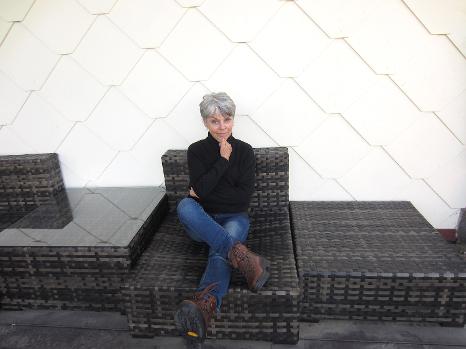about Elizabeth Lindgren, author and illustrator of the Secret of Sooty Wick Inn

Author/ Illustrator Elizabeth Lindgren is a sasquatch fan and a friend to fairies. For inspiration, she wears an Elmer Fudd cap and shares her writing space with a tin goat, cement toad, seven-foot wooden giraffe, and her bicycle. Apart from writing and drawing, she designs and sews whimsical fish, dragons, pixies, and seahorses. Her home is in central Massachusetts.
a Q and A with Elizabeth Lindgren
Where did you get the idea for The Secret of Sooty Wick Inn?
From listening to and observing my husband’s hunting companions who came to my home each fall to strategize, tell stories about deer they’d bagged, and commiserate about the deer that got away.
Why did you choose to become a writer?
My writing came from my love of reading books. I challenged myself to write a book mostly for entertainment. After a while,
I couldn’t stop.
How long did it take you to write the book?
It took twelve years to write The Secret of Sooty Wick Inn. When I began, I had no idea how to do it. Over time I taught myself to write by reading lots of books and analyzing writing styles.
How do you come up with names for your characters?
Sometimes names pop into my head. Other times, I think up a name to suit the personality of a character.
Is the book based on your life or people you know?
Beetle and I share some similarities. We are both small in stature. We are shy and love to draw. However, Beetle makes choices and reacts to situations that are distinctly her own. I modeled Murtha after a self-reliant friend of mine. The farmer in the book is based on a farmer I know who owned an old school bus frequented by chickens.
Who are your favorite authors?
Herman Melville, Ray Bradbury, Dickens, Richard Peck, Susan Cooper, Lois Sachar, Betsy Byars, Mary Downing Hahn, Phillip Reeves, and Scott Westerfeld to name a few.
What were your goals and intentions in this book?
To entertain readers. Beyond that I hope to inspire them to appreciate nature and give writing and drawing a try.
Do you write by logic or intuition or a combination of both?
A combination of both. Writing by intuition is the most fun, but logic gives a book structure.
What did you find most useful in learning to write?
Perseverance and believing in oneself.
What was the least useful or most destructive?
Editing as I wrote and perfectionism.
What is your writing process?
I begin with an idea and a few main characters. Then I come up with a plausible beginning and ending. Finally, I develop a plot.
Themes in the book: choices, endangered species. bio-diversity, secrecy, and trust.